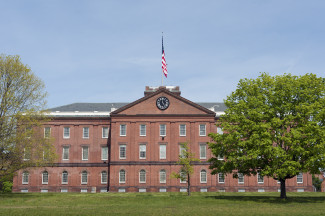
Johns Hopkins UniversityEst. 1876
America’s First Research University
Manufacturing Advantage: War, the State, and the Origins of American Industry, 1776–1848

When I started writing Manufacturing Advantage: War, the State, and the Origins of American Industry, 1776–1848, it had nothing to do with manufacturing. It actually started as a study of piracy and US-Spanish relations during the Latin American independence wars. I had started researching US shipping claims against the Spanish government, while at the same time becoming more interested in the relationship between business and state power. I discovered that one particular group of Boston merchants received a big chunk of federal funds as a result of the settlement of these claims. These same merchants were simultaneously developing the nation’s first fully integrated textile mills in eastern Massachusetts and were able to funnel the capital from the claims settlements into factory development. I began to wonder how else they might have benefitted from state support—whether directly or indirectly. I also became interested in US-South American trade. I had seen references to dyestuffs and hides being imported from South America, and finished goods being exported there as early as the 1820s.
Ultimately, I came to study manufacturing—specifically the arms and textile industries—through diplomatic papers. The richest source was the consular dispatches, which are letters, pamphlets, and trade statistics that US consular agents sent to the state department from their various posts in Latin American ports. In these documents, I began to see a trend in consuls negotiating favorable trade policies, and doing so increasingly for manufactured goods, such as Massachusetts-made coarse fabrics. I also saw several references to arms imports into South America from the US, which piqued my interest. Wasn’t the United States neutral while Latin America fought its independence wars against Spain and Portugal? I did not immediately pursue the arms connection. Then another historian mentioned that a lot of industrial innovation was happening in the arms industry of Springfield, Massachusetts, so I decided to review the records at the New England Branch of the National Archive. In a rare stroke of research luck, on my first day I saw several mentions of the sale of arms to Buenos Aires. This was incredibly exciting to discover, because the United States could not—for diplomatic reasons—openly supply weapons to colonies in rebellion. Federal officials had to arrange these sales in oblique ways through third parties, keeping it as clandestine as possible. Probably for that reason, those were the only references to South American arms sales in federal armory records that I discovered in my research. The more I read, though, the more I became interested in numerous letters written from private gun contractors to the federal armory. These contractors were totally dependent on government patronage. Basically, despite the “right to bear arms” in the United States, there was not enough civilian demand to create a robust arms industry. Textile manufacturers had a different relationship to the federal government; there was a civilian market for textiles in a way there was not for firearms. Government policies, however, shaped the way the industry developed. Diplomatic support, wartime initiative, and trade legislation engendered the growth of certain industries and factory locations.

Pictured above: Springfield Armory National Historic Site in Springfield, Massachusetts
When I began to think in terms of national security, it all made sense. Diplomacy with Spain, or any other nation, meant little without security. As the manufacturers and military participants at an 1812 celebration toasted, “the best mode of warfare for our country: the artillery of carding and spinning machinery and the musketry of shuttle and sledge.”[1] Both the arms and textile industries developed in a system of political economy that I refer to in the book as “national security capitalism:” a mixed enterprise system in which government agents and private producers brokered solutions to the problems of international economic disparities and war. The early national period was fraught with anxieties over whether the new nation would be able to wage war and engage in international relations, or even just survive. Industry offered a solution.
Lindsay Schakenbach Regele is an assistant professor of history at Miami University. She is the author of Manufacturing Advantage: War, the State, and the Origins of American Industry, 1776–1848.
[1] J. Thomas Scharf and Thomas Westcott, History of Philadelphia, 1609-1884 (Philadelphia: L.H. Everts & Co., 1884), 532.


